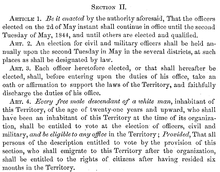Organic Laws of Oregon
| Organic Laws of Oregon | |
|---|---|

Section II of the Organic Laws
|
|
| Created | 1843 |
| Ratified | July 5, 1843 |
| Location | Oregon Country |
| Author(s) | Legislative Committee |
| Purpose | Framework for the Provisional Government of Oregon |
The Organic Laws of Oregon were two sets of legislation passed in the 1840s by a group of primarily American settlers based in the Willamette Valley. These laws were drafted after the Champoeg Meetings and created the structure of a white government in the Oregon Country. At the last Champoeg Meeting in May 1843, the majority of the male European descendants present voted to create what became the Provisional Government of Oregon. Laws were drafted by the committee and accepted by a popular vote in July. These laws were reformed by a second version in 1845.
The Organic Laws were based on the laws of Iowa Territory and compartmentalized the government into three branches consisting of an executive branch, a legislative branch, and a judiciary. Once the Oregon Territory was formed in 1848, the territorial government took control of the laws and invalidated only one provision of the Organic Laws. On February 14, 1859, Oregon became a state and the Oregon Constitution became the legal framework for the state.
In 1841 a series of meetings were held at Champoeg on French Prairie in the Willamette Valley. The first meetings were held in part as a response to the death of Ewing Young who had died without a will. In February 1841 a probate judge was appointed along with a few other positions, but no further movement towards a government occurred.
On February 2, 1843, a new series of meetings began with a gathering at the Oregon Institute in what is now Salem to discuss problems with predatory animals attacking livestock. An assembly with Americans and French-Canadian men, numbering less than 150, was held at Champoeg on 2 May 1843. Measures presented to form a government were tabled, though no record exists of the subsequent voting. The first vote held rejected the presented report due to the inclusion of a governor. A succession of votes were then held for each individual article put forth.William H. Gray states that the tally was 52 in favor of the measures and 50 against them. Another witness, Robert Newell, agrees that 50 men were against the formation, but 55 voted the legislation. According to Newell, the five tie breakers were all French-Canadians, while Gray's account labels the two tie breakers as Americans. Regardless of exact figures of those supporting the presented laws, these votes are held to have created the Provisional Government of Oregon.
...
Wikipedia
